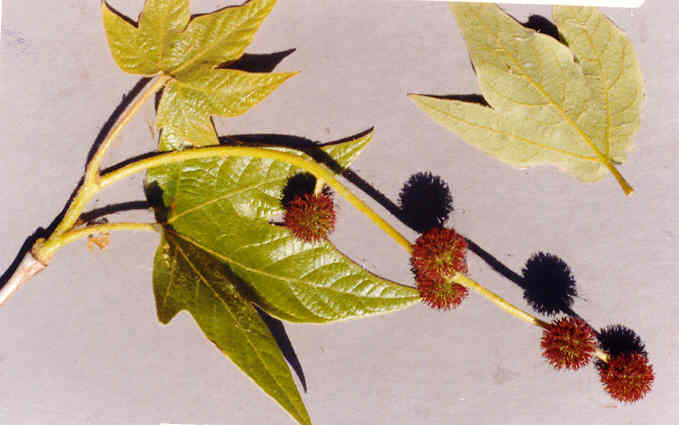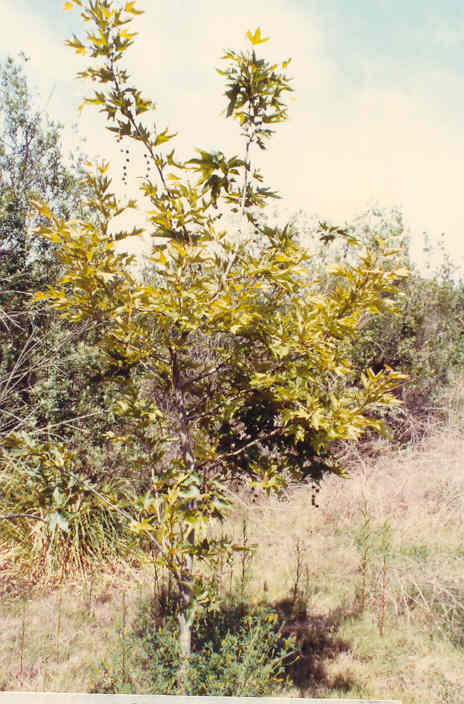
Platanus racemosa Nutt.
 |
Platanus racemosa Nutt.
Platanaceae (Sycamore Family)NativeWestern Sycamore |
March Photo
Plant Characteristics:
Large tree, 10-25 m. tall, with smooth pale bark; young growth rusty-tomentose;
lvs. 1.5-2.5 dm. broad, ca. as long, deeply 5-lobed, the lobes subentire,
tomentose on both surfaces when young, glabrescent above; petioles 3-8 cm. long;
stipules 2-3 cm. long; fls. imperfect, minute, male heads several, 8-10 mm. in
diam.; female heads 3-5, sessile, 2-2.5 cm. in diam. in fr.; calyx of 3-8 minute
scalelike sepals; fr. a dense globose head of aks. with intermingled hairs and
staminodia; seeds elongate-oblong, pendulous, with fleshy endosperm.
Habitat:
Along stream beds and water courses below 4000 ft.; many Plant
Communities; cismontane s. Calif. L. Calif. and cent. Calif. Feb.-April.
Name:
Platanus, Greek, probably
broad, from the leaves. Hickman,
Ed. 822. Latin, racemus, a bunch of
berries. (Jaeger 216). Referring to the fruits.
(my comment). Latin, planus,
plane or flat. (Jaeger 200). The
sycamore is the plain tree of Europe. The
name may refer to the broad flat leaves. (John
Johnson).
General:
Uncommon in the study area. Small
specimens have been found in Big Canyon and in the area where the old salt works
was located. Photographed in both
locations. Several specimens have
been planted in Big Canyon in recent years. (my comments).
When you see our one species of Platanaceae, Western Sycamore, Platanus
racemosa, you have also discovered a stream bed or at least an old stream
bottom. Most often our
sycamores have large, crooked trunks and branches which nearly touch the ground.
The bark near the base of the trunk is dull brown and quite rigid, but
slightly further up the trunk, the bark is smooth and ashen in color with
mottled greenish patches. (Dale
209). Used
in house construction and for wooden bowls by the Cahuilla Indians, inhabitants
of the Colorado Desert, the San Jacinto and San Bernardino Mountains. (Bean
& Saubel 105).
The bark was chipped from the trunk near the ground level.
It was then brewed into a tea, which was used as an aid in childbirth.
Early Spanish settlers used the wood from this tree for wagon wheels.
(Information bulletin prepared by the staff of the Los Angeles County
Museum of Natural History and the Los Angeles County Department of Parks and
Recreation. One page, no date).
Platanus species have been
known to cause hay fever and asthma. (Fuller
381). Susceptible to sycamore
anthracnose. (Hickman, Ed. 822).
The Eastern Sycamore, Platanus occidentalis is generally regarded to be
the largest most massive tree in the eastern United States and in the Ohio and
Mississippi basins it attains its greatest size.
Unlike the California sequoias and redwoods it is old at 500-600 years.
Its hard coarse-grained wood is used for barrels, boxes, butcher blocks,
furniture and cabinets. American
Indians used the trunk for dugouts and one canoe is reported to have been 65
feet long and have weighed 9000 pounds. (Petrides,
George A. A Field Guide to
EASTERN TREES, Eastern United States and Canada Including the Midwest. The Peterson Field Guide Series, Houghton Mifflin
Company, Boston, New York 1998. 267).
Text Ref:
Hickman, Ed. 822; Munz, Flora So.
Calif. 636; Roberts 32.
Photo Ref:
Mar 4 85 #22,23.
Identity: by R. De Ruff.
First Found: March 1984.
Computer Ref: Plant Data 246.
Have plant specimen.
Last edit 10/16/04.
 |
March Photo